

New class of nanoparticle brings cheaper, lighter solar cells outdoors. Think those flat, glassy solar panels on your neighbour’s roof are the pinnacle of solar technology?
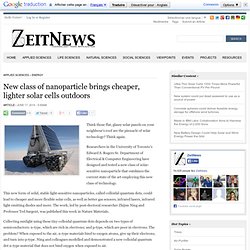
Think again. Researchers in the University of Toronto’s Edward S. Rogers Sr. Department of Electrical & Computer Engineering have designed and tested a new class of solar-sensitive nanoparticle that outshines the current state of the art employing this new class of technology. This new form of solid, stable light-sensitive nanoparticles, called colloidal quantum dots, could lead to cheaper and more flexible solar cells, as well as better gas sensors, infrared lasers, infrared light emitting diodes and more. Collecting sunlight using these tiny colloidal quantum dots depends on two types of semiconductors: n-type, which are rich in electrons; and p-type, which are poor in electrons.
“This is a material innovation, that’s the first part, and with this new material we can build new device structures,” said Ning. Clean Energy, Tech & Web Daily. Dale Pond Lecture - Basic Principles of Sympathetic Vibratory Physics and John Keely Part 1 of 2. A solar plant that's worth its salt. Just past Barstow on Interstate 15, Las Vegas-bound travelers can eye a tower resembling a lighthouse rising out of the desert encircled by more than 1,800 mirrors the size of billboards.
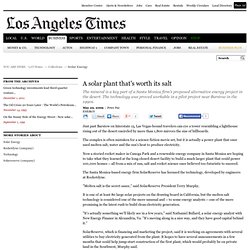
The complex is often mistaken for a science fiction movie set, but it is actually a power plant that once used molten salt, water and the sun's heat to produce electricity. Now a storied rocket maker in Canoga Park and a renewable energy company in Santa Monica are hoping to take what they learned at the long-closed desert facility to build a much larger plant that could power 100,000 homes -- all from a mix of sun, salt and rocket science once believed too futuristic to succeed. The Santa Monica-based energy firm SolarReserve has licensed the technology, developed by engineers at Rocketdyne. "Molten salt is the secret sauce," said SolarReserve President Terry Murphy. The company last fall secured $140 million in venture capital. The plant could begin operating by early 2013. Peter.pae@latimes.com. With Hyundai Australia.
Facebook. Underwater Tidal Kites Are Producing Large Amounts Of Electricity Off The Coast Of Northern Ireland. The Ground Breaking Mathematics That Proves Free Energy Is Possible Has Been Discovered. It has been said that the ability to prove that free energy is possible is non-existent because it defies various physical laws.
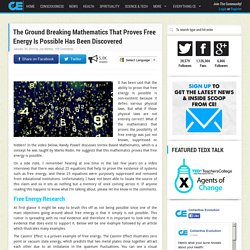
But what if those physical laws are not entirely correct? What if the mathematics that proves the possibility of free energy was just not known, suppressed or hidden? In the video below, Randy Powell discusses Vortex Based Mathematics, which is a concept he was taught by Marko Rodin. Midtech Energy Black Box Power Station. From PESWiki Shortcut URL: Doug Myers, left, and associate, stand with their "black box".
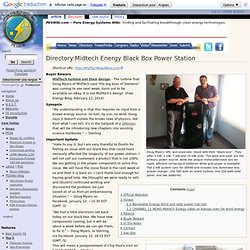
They offer 2 kW, 5 kW, 7 kW and 10 kW units. NASA Admits LENR (Cold Fusion) Game Changer! A Simple Explanation Of Solar Technology. Even without a national renewable energy policy, U.S. solar has made great strides.

The cumulative installed solar capacity of the United States has reached 10 GW, increasing U.S. global share of solar installations by 5% since 2008. Better technology and practices have also brought down the cost of solar. Year over year, the average residential PV system is now down 11.5% from 2012 to $4.81/W, while the average non-residential system is down 14.7% to $3.71/W, according to the Solar Energy Industries Association (SEIA). Giant ‘battery’ ensures renewable supply. The Dinorwig pumped storage station at Llanberis, North Wales, in the UKImage: Jim Barton via Wikimedia Commons By Paul Brown Energy from surplus wind power can be used to pump water uphill and will provide “battery” power to even out energy supply and demand, researchers say.
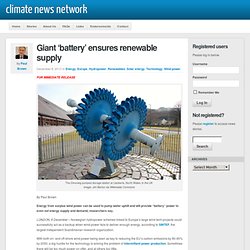
LONDON, 8 December – Norwegian hydropower schemes linked to Europe’s large wind farm projects could successfully act as a backup when wind power fails to deliver enough energy, according to SINTEF, the largest independent Scandinavian research organization. With both on- and off-shore wind power being seen as key to reducing the EU’s carbon emissions by 80-95% by 2050, a big hurdle for the technology is solving the problem of intermittent power production. Sometimes there will be too much power on offer, and at others too little. A northern European offshore power grid is being developed to link wind farms and carry the electricity to population centres where it is needed in Sweden, Denmark and Germany. Goodbye coal!
Giant ‘battery’ ensures renewable supply. Think different The power of HHO selfrunning free energy system running a 400 Watts load. Giant solar plane could stay airborne for 5 years, replace some satellites. Could theoretically stay up even longer...

Solar aviation is still in its infancy, but it's getting better all the time. Sync First: Finally We Have A Solution To Building Your Very Own Free Energy System At HOME! This Is The First One (For Now) I have Come Across For 3D Printing Your Very Own Free Energy Solution. (Video) Sync First: Finally We Have A Solution To Building Your Very Own Free Energy System At HOME!

This Is The First One (For Now) I have Come Across For 3D Printing Your Very Own Free Energy Solution. This glass sphere might revolutionize solar power on Earth. German architect André Broessel, of Rawlemon, has looked into his crystal ball and seen the future of renewable energy.
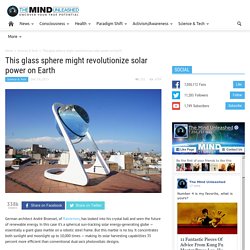
In this case it’s a spherical sun-tracking solar energy-generating globe — essentially a giant glass marble on a robotic steel frame. But this marble is no toy. It concentrates both sunlight and moonlight up to 10,000 times — making its solar harvesting capabilities 35 percent more efficient than conventional dual-axis photovoltaic designs. André Broessel was a finalist in the World Technology Network Award 2013 with the globe’s design and afterward produced this latest version, called Betaray, which can concentrate diffuse light such as that from a cloudy day. André Broessel’s latest invention looks like something out of a superhero movie.
Standard Energy Supply Company: NPD Solarbuzz Predict Massive 49 GW Solar PV Demand for 2014. NPD Solarbuzz have released their final 2013 NPD Solarbuzz Quarterly, and they are predicting that the solar PV industry is set for “explosive growth” in 2014.

December is always the busiest time of year for analyst firms, as they look back at the year that was and forward into the year to come. We’ve already seen NPD’s predictions for the Asia-Pacific region, predicting that half of global PV demand for the world will come from that one region, while IHS and the Mercom Group both released their 2014 analyses, predicting between 40 to 45 GW to be installed worldwide in the coming year. But I’ve been waiting for the NPD Solarbuzz report, relying on their analysis and predictions over the others. Booming Solar Energy Halted by Hawaii Utility Because Sun Produces Too Much Power!
Let's try to summarize this astounding Scientific American article that symbolizes the tentacles of the fossil fuel industry and utility companies in perpetuating destructive climate change. Actually, the header and sub-headline of the piece sum it up nicely: "A Solar Boom so Successful, It's Been Halted: Photovoltaics proved so successful in Hawaii that the local utility, [the Hawaiian Electric Company] (HECO), has instituted policies to block further expansion. " Hawaiian residents are investing their own money to save longterm costs and the environment. The result is that they are producing a surplus of solar energy beyond what they can use in their homes. This extra energy is supposed to be diverted back into the power grid to save money on HECO's reliance on oil and to reduce global warming. MIT Actually Reinvented The Wheel.
Main Page - PESWiki. Air-Purifier Bike: Bicycle that purifies the air "Neoteo. Free-Energy Devices, zero-point energy, and water as HHO fuel. 7 New Solar Innovations That Could Change The World. It’s a tough time for solar innovation. Heightened global solar PV production, especially in China where production has multiplied 17 times over the last few years, has created such an oversupply of panels that prices have dropped 80% in the last four years. Plummeting prices is exciting news for the distribution of solar energy, but threatens to stymie innovation of new clean energy products.
Solar technology startups that are attempting to break into the PV market are finding it challenging to make even the most innovative products cost effective when the cost of traditional solar panels is so low. The disappointing buyout of MiaSole and crash of Solyndra are cacophonous illustrations of the difficulty of this new landscape. But fret not, Mosaic is here to remind you that there are still opportunities for innovative new technologies to transform our clean energy future. 1. There are 1.2 billion people in the world who live without access to electricity. 2. 3. 4. 5. 6. 7. Shimizu's Luna Ring to beam solar energy from the Moon.
A Japanese firm has come up with the idea of constructing an array of solar cells around the Moon's equator to harvest solar energy and beam it back to Earth. The Shimizu Corporation proposes creating a "Luna Ring" using materials derived from lunar soil along its 11,000-km (6,800-mile) equator. The plan involves starting with an array that's a few kilometers wide and eventually increasing that to around 400 km (250 miles).
The goal is to generate a continuous stream of power from the Moon's lunar equator, which receives a steady amount of exposure to the Sun, and beam it down to Earth from the near side of the Moon. It's an ambitious idea that calls for assembling machinery transported from Earth and using tele-operated robots to do the actual construction on the Moon's surface, once it arrives. The multi-phase project, to be spread out over a period of 30 years, envisions creating construction materials using a combination of strategies. What happens when you collapse an underwater bubble with a soundwave? [VIDEO] Two for one in solar power. Solar cells offer the opportunity to harvest abundant, renewable energy. Although the highest energy light occurs in the ultraviolet and visible spectrum, most solar energy is in the infrared.
There is a trade-off in harvesting this light, so that solar cells are efficient in the infrared but waste much of the energy available from the more energetic photons in the visible part of the spectrum. When a photon is absorbed it creates a single electronic excitation that is then separated into an electron and a positively charged hole, irrespective of the light energy.
One way to improve efficiency is to split energy available from visible photons into two, which leads to a doubling of the current in the solar cell. Tiny Off-Grid Cabin in Maine is Completely Self-Sustaining. A project 30 years in the making, this tiny off-grid retreat on a coastal island in Maine is almost entirely self-sufficient. Designed and built by Alex Porter for her father, the project features a shed roof and is wrapped in a distinctive blue-grey corrugated skin. Dwell recently profiled the home, which is the only solar-powered retreat on the isolated island – its sustainable power source actually makes life a lot more leisurely, as the family does not need to schlep in fuel to run a noisy generator. They didn’t give anything up, as they have all the conveniences of a regular home — but with a view you don’t get in an everyday residence. The house is situated on a tiny sleeve of rock tucked close to the water. The sturdy steel cladding was chosen for a good reason: the northern squall can be relentless.
Illinois Research Team Turns Wood into Greener Next Generation Battery Super Capacitors. Over the last few years researchers have been developing supercapacitors to become the next-generation battery. Solar Shade Umbrellas Recharge Community Space in Fort Douglas. By Alicia Wrigley-Gailey, Office of Sustainability Campus residents will soon have a new space to recharge—both personally and electronically—thanks in part to a Sustainable Campus Initiative Fund (SCIF) project. In the coming weeks, ground will be broken for a new outdoor gathering area near the Shoreline Ridge Student Apartments.
The space, which will feature tables, seating, and a natural gas fire pit, will be covered by eight umbrella-like shade structures made of 32 solar panels. Elon Musk. The power of footfall: how cities of the future will harness energy. RenewableChoice : Wondering why it's so important... Hutchison demonstrates Zero Point Energy. Clean Tech Now. How Green Is a Tesla, Really? This story first appeared at Slate and is reproduced here as part of the Climate Desk collaboration. The knock on electric cars has always been the same: They're great for the environment, but they're pokey and impractical, and nobody wants to buy one.
Super Thin Graphene Solar Panels Could Pave the Way for Powered Paint. Plug into a plant: A new approach to clean energy harvesting. New technology out of the University of Georgia allows energy generated by plants through photosynthesis to be captured before the plants can make use of it (Image: Shutterstock) Image Gallery (3 images) Lithium-ion batteries from Rice University can be painted on nearly any surface. Highly Transparent Polymer Solar Cell Produces Energy by Absorbing Near-Infrared Light. Visibly Transparent Polymer Solar Cells Produced by Solution Processing. Energy Harvesting: Nanogenerators Grow Strong Enough to Power Small Conventional Electronic Devices. Hybrid Electric Energy: Self-Charging Power Cell Converts and Stores Energy in a Single Unit. Solar Roadways: The Prototype. Motor-Generator Self-Looped with Usable Energy Left Over. Electricité gratuite. Www.free-energy-info.co.uk/PJKbook.pdf. POWERJMD - prototype 2 - free electricity - free energy - électricité gratuite - énergie libre.
In Haiti, 1,800 Solar Panels Power a Brand-New Hospital - It's Not Easy Being Green. Perpetual Motion Machine. Magnetism & Gravity. How to Build a Solar Heating Panel with Soda Cans. 7 DIY Pop Can Solar Heaters. Energy harvesting: Lighting the office - by walking. Resonance in Giant Piezoelectric Levitation Basins. Breakthrough Energy Movement. Peru Solar Power Program To Give Electricity To 2 Million Of Poorest Peruvians. TRUCK RUNS 100 % on WATER NOT on GASOLINE.
Organic solar cells that collect energy like plants. When Will Solar Get Cheap Enough for Everyone to Use? How to Get Cheap Solar Power.